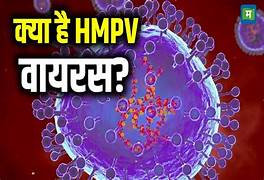HMPV in India: What We Know So Far
Human Metapneumovirus (HMPV) is a respiratory virus that has drawn increased attention in recent years due to its global prevalence and impact, particularly among vulnerable populations. While it was first identified in the Netherlands in 2001, retrospective studies have shown that HMPV has been circulating worldwide for decades. In India, this virus has gradually become a significant concern, especially during respiratory infection seasons. This article explores what we know so far about HMPV in India, its characteristics, transmission, symptoms, diagnosis, treatment, and the measures necessary to combat its spread.
What is HMPV?
Human Metapneumovirus belongs to the Paramyxoviridae family, which also includes respiratory syncytial virus (RSV) and parainfluenza viruses. It primarily affects the respiratory system, causing illnesses that range from mild colds to severe respiratory infections. HMPV is particularly dangerous for:
- Young children (especially those under five years old)
- Elderly individuals
- Immunocompromised patients
- People with underlying respiratory conditions like asthma or COPD
HMPV infections are more common during late winter and early spring in temperate climates. However, in India, a country with diverse climatic zones, the patterns of HMPV transmission are less predictable and influenced by regional weather patterns and population density.
HMPV in India: The Current Scenario
HMPV infections are not new in India, but awareness about the virus remains low among the general population. Respiratory illnesses often spike during monsoon and winter seasons in India, which are ideal conditions for the virus to spread. Studies conducted in Indian healthcare settings have detected HMPV as a cause of respiratory infections in both pediatric and adult patients, though it is often overshadowed by more well-known pathogens like influenza, RSV, and SARS-CoV-2.
Prevalence
- Studies from hospitals in India suggest that HMPV contributes to 5-15% of respiratory infections in children admitted to healthcare facilities.
- While HMPV is not as prominent as RSV or influenza, its contribution to the disease burden is significant, particularly in areas with high population density.
Challenges in India
- Underdiagnosis:
HMPV infections are frequently underdiagnosed due to limited access to advanced diagnostic tests in many regions. - Overlap of Symptoms:
The clinical presentation of HMPV often overlaps with other respiratory viruses, making it difficult to distinguish without laboratory tests. - Limited Awareness:
Among healthcare professionals and the public, awareness of HMPV remains low, leading to misdiagnosis and delayed treatment.
Symptoms of HMPV Infection
HMPV causes a spectrum of respiratory illnesses ranging from mild to severe. The severity often depends on the patient’s age, immunity, and pre-existing conditions.
Common Symptoms:
- Runny nose
- Cough
- Fever
- Nasal congestion
- Sore throat
Severe Symptoms:
- Difficulty breathing
- Wheezing
- Chest tightness
- Pneumonia
- Bronchiolitis (inflammation of the small airways in the lungs)
At-Risk Groups:
- Infants and toddlers often present with severe symptoms, including bronchiolitis and pneumonia.
- Older adults and those with weakened immune systems are prone to complications like respiratory failure.
Transmission of HMPV
HMPV spreads similarly to other respiratory viruses, primarily through:
- Respiratory Droplets:
When an infected person coughs or sneezes, the virus spreads through the air. - Direct Contact:
Touching surfaces or objects contaminated with the virus and then touching the face (mouth, nose, or eyes) can lead to infection. - Close Contact:
Family members, caregivers, and healthcare workers are at increased risk of contracting the virus from infected individuals.
In India, factors such as crowded living conditions, limited access to hygiene facilities, and poor air quality exacerbate the transmission of respiratory viruses like HMPV.
Diagnosis of HMPV
The clinical symptoms of HMPV overlap with many other respiratory illnesses, making laboratory testing crucial for an accurate diagnosis.
Diagnostic Methods:
- Polymerase Chain Reaction (PCR):
PCR tests are the gold standard for diagnosing HMPV as they detect the virus’s genetic material. - Rapid Antigen Tests:
These are quicker but less sensitive compared to PCR tests. - Serological Testing:
Measures antibodies in the blood to determine past infections but is less useful for acute diagnosis. - Chest X-rays or CT Scans:
These may be used in severe cases to assess lung involvement but are not specific for HMPV.
In India, the availability of PCR testing is limited to larger hospitals and research centers, posing a challenge for timely diagnosis in rural and underserved areas.
Treatment of HMPV
There is no specific antiviral treatment for HMPV. Management is primarily supportive, focusing on alleviating symptoms and preventing complications.
Supportive Care:
- Hydration:
Drinking plenty of fluids to prevent dehydration. - Fever Management:
Using paracetamol or ibuprofen to reduce fever and alleviate discomfort. - Oxygen Therapy:
For patients with severe respiratory distress, supplemental oxygen may be necessary.
Hospitalization:
- Infants, elderly individuals, and immunocompromised patients may require hospitalization if their symptoms worsen.
Research on Antivirals:
Experimental antiviral drugs and monoclonal antibodies are being explored as potential treatments for HMPV. However, these are not yet widely available or approved for routine use.
Preventing HMPV Infection
Preventing the spread of HMPV involves adopting general measures to reduce the transmission of respiratory infections.
Hygiene Practices:
- Wash hands frequently with soap and water.
- Use hand sanitizers when soap is unavailable.
- Avoid touching the face with unwashed hands.
Respiratory Etiquette:
- Cover your mouth and nose with a tissue or elbow when coughing or sneezing.
- Dispose of used tissues properly.
Avoiding Close Contact:
- Maintain physical distance from individuals showing symptoms of respiratory illness.
- Isolate infected individuals when feasible.
Disinfection:
- Clean and disinfect frequently touched surfaces regularly, especially in households with sick individuals.
Vaccination:
While there is no vaccine for HMPV yet, researchers are actively working to develop one. Once available, it could significantly reduce the burden of HMPV infections, particularly in high-risk populations.
HMPV and COVID-19
The COVID-19 pandemic has overshadowed HMPV, but its lessons are relevant for managing all respiratory viruses. The overlap of symptoms between HMPV and COVID-19 has complicated diagnosis and treatment, emphasizing the need for multiplex testing to identify co-infections. The infrastructure developed for COVID-19 testing and surveillance in India could be leveraged to improve HMPV detection and management.
Conclusion
Human Metapneumovirus (HMPV) may not yet be a household name in India, but its impact on public health cannot be ignored. The virus poses a significant threat, particularly to vulnerable populations, and requires increased attention from both healthcare professionals and policymakers. Enhanced diagnostic capabilities, public awareness campaigns, and research into treatment options are crucial for addressing the challenges posed by HMPV.
India’s diverse geography and socio-economic disparities necessitate a tailored approach to managing HMPV. By leveraging advancements in diagnostics, improving access to healthcare, and promoting preventive measures, India can mitigate the impact of HMPV and safeguard the health of its population. As the medical community continues to learn more about this virus, collaboration between researchers, healthcare providers, and governments will be essential in combating HMPV effectively.


